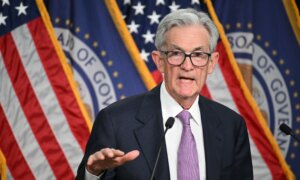News Analysis
The Bureau of Labor Statistics (BLS) will release a monthly labor market report this Friday.
The report will show that the U.S. labor market cooled off in October as job growth slowed, and unemployment and wage growth remained steady, based on the consensus estimate among analysts compiled by Tradingeconomics.com.
According to the site, the U.S. economy added 123,000 jobs in October, down from 254,000 in September. The unemployment rate remained steady at 4.1 percent, and wages grew at an annual rate of 4 percent, in line with the September rise.
One reason for this slowdown is the lagging effect of previous interest-rate hikes, which hurt cyclical industries, namely businesses that are more sensitive to changes in the larger economy.
Another reason is the Boeing strike. The BLS treats striking workers as temporarily unemployed, distorting the unemployment numbers.
A third factor is the labor-market disruptions in hurricane-hit states like Florida, which disrupted economic activity.
Still, Scott Helfstein, head of investment strategy at Global X, expects the big job miss this week to be in jobs where investors have been a little skittish about a softening labor market.
“Nonfarm payrolls are expected to slow meaningfully from last month and could come in light after that disruption from the hurricanes,” Helfstein told The Epoch Times via email. “The trend, however, has pointed to robust job creation.”
A.J. Mizes, CEO and founder of The Human Reach, agrees. He, too, sees the U.S. job market on an uptrend, referring to September’s 254,000 jobs that beat consensus expectations by a significant margin.
“But what a lot of people don’t realize is that this hiring surge wasn’t just a lucky break,” he told The Epoch Times via email.
“It’s part of a predictable cycle every year in the third and fourth quarters when companies ramp up hiring to prep for the new fiscal year and bring on talent before the holiday slowdowns. If you’re serious about landing a job, this is when you should be making your move.”
Ryan Dossey of SoldFast.com sees strong demand for positions that allow work-from-home or remote flexibility.
“I’ve run CallPorter.com since 2017, and our U.S.-based call center reps have been remote since our inception,” he told The Epoch Times in an email. “The last time we posted on Indeed that we were hiring, we had 78 applications on the weekend for entry-level work from college graduates.”
Still, Mizes doesn’t expect another strong hiring in October, like that of September, due to the upcoming presidential election, which will likely make companies cautious about hiring new employees.
“But that shouldn’t be an excuse to put your job search on hold,” he said. “The job market might look uncertain, but the opportunities are there for those ready to take them. Everyone is holding their breath for the weeks after the election to see if the ‘hiring slingshot’ is released.”
Cooling the labor market will allow the Federal Reserve to continue easing monetary policy, though at a moderate rate, due to stubbornly high inflation.
According to the CME FedWatch, the probability of a 25 basis-point cut in the federal funds rate has increased, from 46.7 percent a month ago to 94.8 percent on Oct. 29. Meanwhile, the chances of a more significant 50 basis-point cut have decreased, from 53.3 percent to zero over the same period.
“The Fed will likely be watching the data this week,” Helfstein said. “The most likely outcome is that inflation and jobs reports stay on trend, reinforcing the belief that the Fed does two more 25 basis-point cuts this year.
Moderating job growth and lower interest rates are positive trends for equity markets. Continued job growth will allow listed companies to deliver solid earnings in the coming reporting seasons. At the same time, lower interest rates will make these earnings more valuable when discounted to the present.
Helfstein sees another positive for equities: cash on the sidelines.
“There are still large pockets of cash on the sidelines that could be deployed given a healthy economy, strong fundamentals, and declining rates, but chasing the index might not be the best move,” he said. “Plenty of reasonably priced opportunities in growth and income are set to benefit from secular and cyclical trends.”














